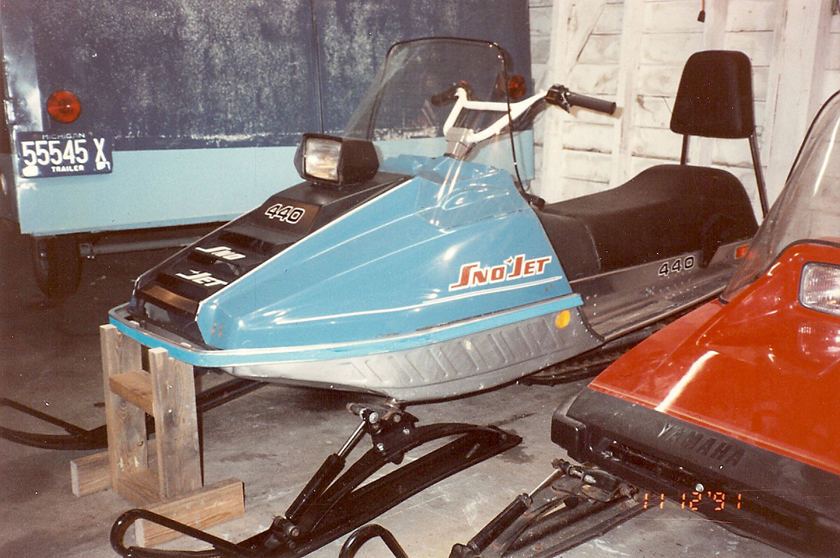
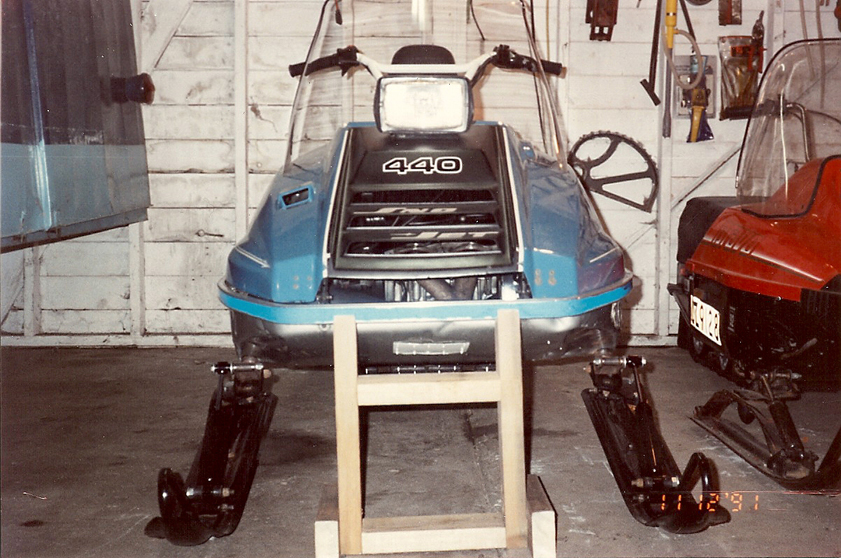
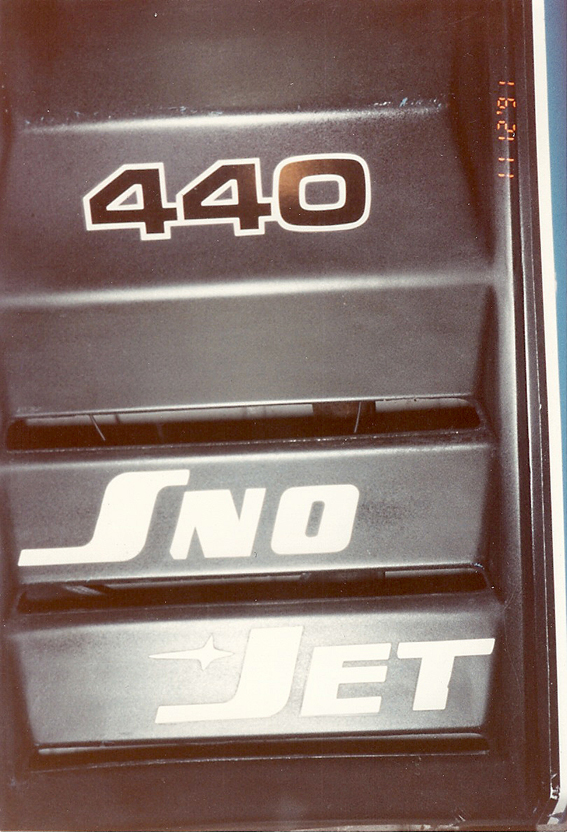
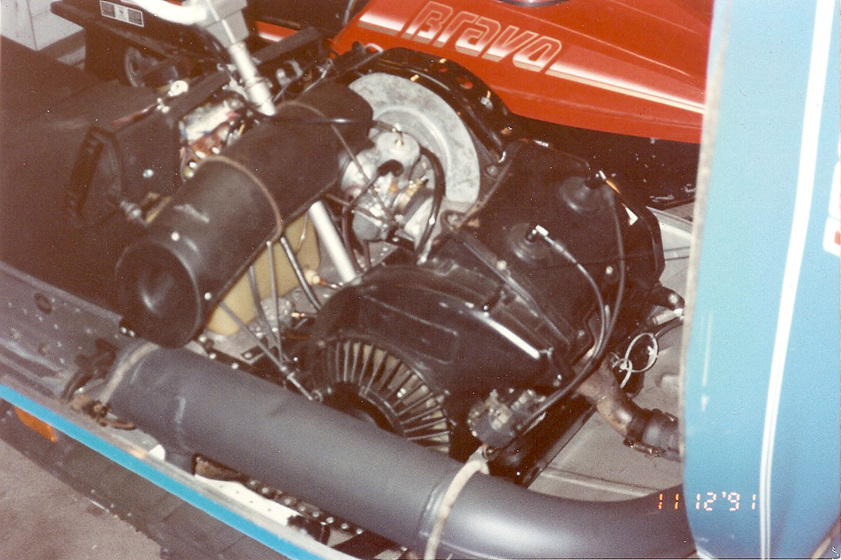
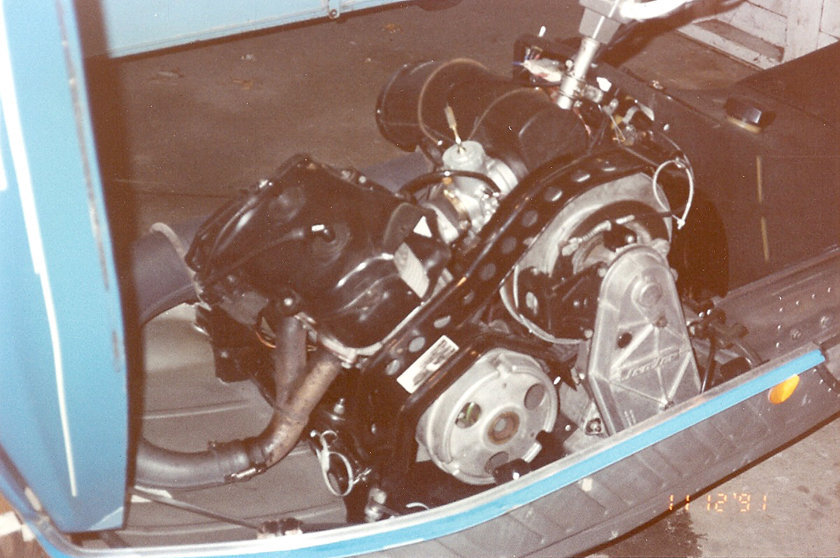
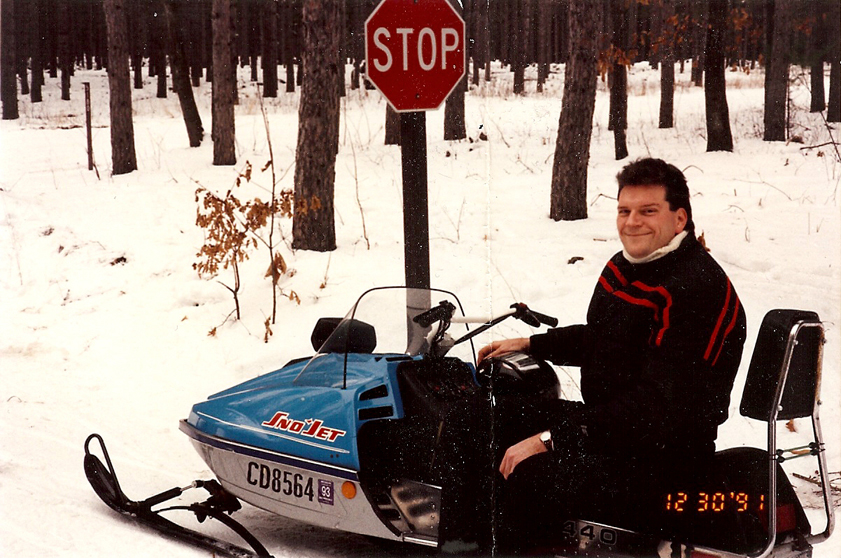
How I came into possession of it, not once but twice.
It was winter of 1990-91 and I had located my original 1974 Sabre Jet 650. The current owner however was not ready to sell it to me, he promised he would, when he was ready. I was looking for a new (used) sled to ride, my current ride was a 1973 TNT 294. Remember this was 1990, until recently I had been out of sledding for ten years, I had little money for sledding, and the whole vintage hobby hadn’t really taken off yet. Back then there were many “vintage” sleds still on the trails as everyday riders. I had always loved the 75-76 SST’s and remember when they were being blown out at clearance pricing at Caswell Ford, the Sno Jet dealer in Ionia Mi. Caswell’s decided to leave the snowmobile business after the Kawasaki acquisition. I figured while I was waiting to re-claim my 650, I would look around for an SST.
My home was in metro Detroit, the biggest medium for buying and selling of this type was what was called the Trading Times. It was a paper format without pictures and I would pick one up on it’s release day each week and look for those three initials “SST”. The first part of March 1991, I came across an add for one in Bloomfield, Mi It stated that it was a 1976 440 and I called immediately and left a message. My hope was to purchase it and still be able to get a late winter ride in prior to all the snow melting up north. I did purchase it for 350 but the ride would have to wait until the following winter.
When I arrived a young man met me to show me the sled in the garage. When I asked why he was selling it, he said that they don’t ride anymore, he hadn’t ridden in years and his girlfriend didn’t like to ride. When I asked how long he had it he said that they had it since new. He went on to say that his Dad had worked for Sno Jet, he got it from work and had given it to him later. When I heard this I told him about the 650 Sabre Jet that I used to own and he told me that his dad worked on many sleds for the factory back then and had a lot of them around including the 650 Sabre Jets. “Vintage” “History” Pfffft, I cared little at the time! WOW, if I could go back and ask the questions I have now, 20 years later, how nice that would be. He had grown up around sleds and seemed to know a lot about them. I didn’t ask a lot of questions, I didn’t even look it over that well. I wasn’t as versed as I am now in thoroughly going over a sled. It seemed shinny, it had only a few hundred miles, everything worked, it ran well and I knew I wanted it. One thing I couldn’t help noticing was that the exhaust outlet was welded kind of funny on the pipe housing and the area in the belly pan where the exhaust outlet is, was cut wide open in that area. I questioned why this was the case and he told me that when his dad was working on it at the factory there were several different pipes tried on it. I was excited to get it loaded and home, now mine! I never gave much thought to what kind of graphics were on it whether they were correct or not, any of that. It was going to be my riding sled for the next season and I was looking forward to getting it ready. I do recall thinking it was odd there were no SST insignias on it other than the brand in the rear of the seat.
Once home I couldn’t wait to clean it up and do some maintenance on it. It was then I really started to check it over that I felt it was in kind of rough shape for so few miles. The suspension had a wheel with its rubber missing, many track clips were broken a shock in the rear was broken etc. Of course I never even looked under it when I bought it, LOL. It had its share of dings and cracks. There was another place in the front of the belly pan that had worn thru due to exhaust rubbing on the aluminum. All this in a few miles, again it just seemed like it had taken a beating at times and lived a rough life. The speedometer was hooked up and worked and I had no reason to believe it had been disconnected. It was pretty complete from my memory, with a couple exceptions. It had no tunnel grab handles, the tool bag had the bottom rotted out of it, the front yellow reflector on the PTO side was missing and it had no windshield. It did have a swank sissy bar style backrest, which I thought was pretty odd, and reminded me of our old stingray bikes in the early seventies.
Since I couldn’t ride it for 9 months I decided to completely clean it, paint some rusted parts and repair anything that needed it. Being an engine guru, I figured I would tear the motor apart, check it all out, at least replace the seals and gaskets. Here is what I recall doing to it:
I finished the project in early November and took some pictures to show my brothers over Thanksgiving. Pictures were not something I took many of at that time in my life, I was pretty proud of it and even more excited for the coming winter and to ride it, so pictures I took. Thankfully, because little did I know how important those pictures would become over 20 years later. The sled was registered as a 1976, it had no tags indicating its model serial or build date, it just had the serial number stamping in the tunnel and an unusual number of small holes where the tag should be affixed with some rivet heads still in some of them. This was my main riding sled until I bought my brand new 1993 Arctic Cat 580Z on the day after New Years 1993. I continued the balance of that winter riding it a little and then sold it to a friend that I worked with. It wasn’t until the years passed, I acquired many Sno Jet books, I took more of an interest in vintage sleds and the internet came about that I realized something was very different about the SST I had.
Here are some of those pictures I took back in 1991:






The sad truth is, it was in very rough and neglected shape. It had sat in the back of a shed, with a dirt floor for over 10 years, meaning it was now IN the dirt with many things stacked on it and against it. The owners Dad proudly crowed about how he did such a GREAT job of re-painting it with basecoat clear coat in two different hues of NON Sno Jet Blue, of course removing all the decals with the exception of the cowl sides, which he SO carefully taped around to paint. The truth is they had no idea what they had. Prior to seeing it, I was assured by the owner of the “pretty good condition” it was in and the fact that a chunk was missing from one of the pistons and there were numerous other issues that wouldn’t allow it’s immediate running, seemed to escape his description. Instead he chimed about how “great it ran”. I think he forgot to add the words “used to” or maybe he intended the word “ran” in the past tense, LOL. Thankfully in the end he didn’t seem to think it was worth a ton of money and we were able to work something out. I had NO intention of buying a sled in this kind of shape, BUT, my curiosity and believing something was special about it, wouldn’t let me walk away.
Here are a couple pictures of how it looked when I re-acquired it in March 2011.
The Restoration
Tearing the seat apart one night to restore the base, and prepare it for recovering, confirmed the sleds identity. Tucked between the bottom firm foam layer plug and the main foam layer, were the original serial/model tag and five other tags with stampings on them. They had been; coated in something that became nearly brittle and folded in layers with what may have been saran plastic wrap. The serial/model tag, stated “PROTOTYPE”, OH MY! The other five tags appear to have been used somehow in its development evaluation process. Many things began to make more sense and it became evident what all the small holes were in the side of the tunnel. The main tag didn’t appear to have ever been installed, the other five had been, and at some point were literally pulled off ripping their rivet holes in the process. Prior to finding these, I had already been told by a former large dealer, who sat on the Presidents Council and frequented the factory often, that he recognized it and that it was a prototype. Finding this missing piece, which every rider had literally been sitting on, was very motivating. Determining the direction of the restoration became very important at that point.
After talking to and getting some insights from other restorers and former Sno Jet people I determined the primary restoration guidelines would be;
Here is a listing of the variances made;
Being a prototype, naturally it had a number of things that weren’t like the production units. Following is a summery of parts and findings that are unique or not typical compared to a production SST.
As I was wrapping the project up in early November 2011 I had the task of displaying the tags. I could not install them where the factory had installed them as the small tags had been torn off and new holes would have to be drilled in them. In addition, It would not be feasible to have them all installed at the same time as they had to have been haphazardly installed and maybe not all at the same time. The main proto tag appeared to have never been installed on the sled. Considerable time was spent to restore these tags without damaging them, a combination of products along with hand etching, dremel wire brush work and light sanding was required to remove the coating, and then a quick layer of clear to restore some luster and sharpness. This part of the project I left until last as I pondered how to display them while I did the restoration. The idea came to me at one point along with a background graphics piece and just the rite place to display them. The back of the backrest, I like it!
Spending hours reading and searching documents proved valuable but what proved invaluable was making contact with a number of former Sno Jet employees, dealers and associates. Some of which worked directly within engineering, design and prototypes.
In doing this research I have communicated with several former Sno Jet personnel and associates, they all were very helpful. I am sincerely thankful and appreciative of the time and information everyone contributed. Most did not want their name on the web or in print media, two individuals willing to have their names mentioned were Peter Morris and Gordon VanAmburg. Nearly all of the communication was verbal with the exception of Peter Morris. Almost without exception, each individual stated that, it has been 30-40 years and the information is to the best of their memories. The best way for me to organize it was to combine the information into a series of articles. The research migrated into several Sno Jet related topics, making it impossible to include it all in one. I have written additional articles on the topics of, Prototypes and the Phantom Jet, Presidents Council and Presidential FA’s and Targeted History Timeline Sno Jet.
This prototype was built December 1974 as Sno Jet ended its 1975 model production, a model year that had seen the launch of the all new SST and Astro SS. Over 600,000 just in engineering and tooling had been invested in getting the new SST into the publics hands. Sno Jet had some very aggressive plans which had begun a couple years prior with the implementation of a three phase 3.5 million expansion of its manufacturing and parts capabilities and plans for a two phase new model release. The first phase of the new model release was the all-new SST, the second phase promised to be revolutionary and was planned for the 1976 model year. Sno Jets plans were BIG, they had their sites set on the likes of Bombardier, Polaris and Cat. They believed that in order for them to be sustainable long term, they had to become one of the manufacturers at the top of the heap and they honestly felt they could do it. Incidentally it was the success of the Thunder Jet and the effect it had on the company that opened many eyes and fueled the drive and ambition, the spark that ignited the flame if you will.
A number of uncontrollable factors were working against Sno Jet at the time, the timing couldn’t have been worse. These included; the economy, fuel, lack of snow and thousands of leftover units sitting in inventories. If these and other factors hadn’t existed, would they have pulled it off? We will never know but it wouldn’t have failed due to a lack of determination on their part. Unfortunately as the 1975 model year came to an end and the new year came about, severe difficulties and turmoil were already solidly in play. One problem was its own planned phase two, new revolutionary model launch for 1976, had been scraped due to a combination of the pre-mentioned and engineering issues which otherwise may have been resolved. A reassessment of the upcoming 76 model lineup took place. It was determined that the SST fan needed increased performance and a thorough evaluation to keep up with swift moving competition, especially in light of no new model releases. And so this prototype was born.
Looking quickly at the other models that existed;
F/A SST - Was considered fine for the time and short lived, maybe another year or two and may receive some updates based on the evaluation above. Sadly these were later dropped as the situation spiraled down.
Astro SS - would remain as is and may receive some updates based on the evaluation above.
Astro Jet - would remain as is
Whisper Jet - I have purposely left this one last. It had been slated for replacement with the new chassis release, which would have ideally accounted for multiple new models and was hoped to have been the platform for Sno Jets first liquid cooled model although not in 1976.
This prototype was used to test and develop refinements and potential changes. One of its many assignments included being the test bed for the “NEW ’76 POWER PACK …MEANS YOU GET 20% MORE S-S-S-S-SST!” The fan-cooled sleds during this time were seeing some pretty substantial increases in h.p. with better engine technology and the migration away from older industrial engines to purpose built engines. Even though Sno Jet got its engines fully engineered from Yamaha, it had its own engineers to maximize the potential and develop their choice of carburetion, drive and exhaust systems to meet their applications and objectives. This new “Power Pack” consisted of a new exhaust system, new Arctic clutch, new Mikuni carburetor and a Yamaha “E” version engine with reworked port timing, new pistons, reworked intake, 30mm taper crank and enlarged cooling fan area. The package increased the peak power to 50h.p.
Progress was taking place at an un-ordinarily slow pace during this time. It was obvious to those at Sno Jet that Conroy was giving up on the industry, wanted out and the future was very uncertain. We know based on history this “Power Pack” development was still not complete by April 1975 as the SST Sno Jet sent for magazine testing was incomplete. The 440 SST sent was a 1975 production sled with an “E” engine transplanted and an Arctic clutch slapped on. It still retained its 75 exhaust and Keihin carburetor. In the end the “Power Pack” was the only major change to the 76 model, even the graphics stayed the same. As the future evaporated before them, the decision was made to stop development, produce a very limited model line-up and work to facilitate Conroy’s exit from the industry. Production of 1976 models began October 75, Arctic Cat was contracted to assemble the units with parts supplied by Sno Jet and some from Cat.
As of this writing, there are only 3 maybe 4 prototypes that Sno Jet built, known to be in existence. Sno Jet had a very strict policy and that was, prototypes of every form were to be destroyed when their purpose had been completed. Even the company employees were not allowed to acquire the prototypes, the only exception was that some parts were maintained at times for future use within the departments. Two confirmed Phantom Jets and a third Phantom Jet that seems to elude any investigation and may be confused with one of the other two as ownership has changed fairly frequently since they have been known to exist. The only other prototype is the main character in this story and Sno Jet’s final one built. Here is a timeline of the final years prototypes built by Sno Jet.
Interesting Quotes:
Virtually all of my communication with Peter Morris was written which made it nice to refer to over notes and handy to select some interesting quotes from. Thanks Pete for your additional time spent typing and the willingness to be quoted.
“I can honestly say that I would have personally driven your SST, up here in Vermont, probably when it only had a couple of miles on the odo.” “So, given that, I would have been one of the few who helped remove its virginity.” Peter Morris
“We had become major curiosities in our neighborhood, as we often came home with prototype sleds… yours, in fact, and friends would gather to check out the sleds. "Wow... what the hell is that?... A Sno-Jet... I checked out the showroom last week, and never saw one like that... Well, this one is a 1976 model...” Peter Morris
“Considering the prototypes were just intended to be test beds, and never to end up in the hands of the public... …features your sled should have on it. That would certainly depend on what week (or even day of the week) during its evolution! Those poor rascals had likely seen every spring and shock combination, several track and slide suspension we had considered, different heights of windshields, whacked up cowls, different decals on the port side from the starboard... and probably nearly everything on the proto sled, looking for the best and most reliable (within budgetary boundaries) set ups for the final production models. So, on the day the protos were officially retired, that version may have been the closest to production specs... but not necessarily!” Peter Morris
“Your SST may have had a half dozen different track suspensions and ski spindle angles tried before it was retired. And the production SSTs may have ended up with different details than anything ever applied to the prototypes.” Peter Morris
“I believe that since there were strict legal conditions on what a prototype could be… …when it’s time as a test bed was done, you could save it for a life in a museum setting, or scavenge parts to go back in the shop for internal use, or just (sadly) send it to the crusher. But, never under any circumstances should it be sold as a production sled--- new, or used. Thus the badge, to prevent that.” Peter Morris
“…some of the main players in the development of the SST: Randy Eilert, stylist/ Phil Craven?/ main engineer/ Harlan Lipker, proto mechanic, Jean-Pierre Monfette and Gene Whitney, clay modelers. There would have been others who were involved in a less hands-on way... like VPs, marketing, service and parts, etc… …Mr. Monfette may have a bunch of pix of the clay model as it took form. I believe I did the drafting for the decals and appliqués, and actually cut them from film with a #11 Exacto knife.” Peter Morris
“I remember too, cutting some stripes that ran just under the side of the seat on the tunnel. But half the time we would never know what made the final cut until we saw next year’s brochure on a desk? I do also remember cutting some Sno-Jet logos for the cowl that had a red center and white borders” Peter Morris
“We experimented with several components from Arctic-Cat, and many were used in production. Eg: we bought our engines from Yamaha, clutches and tracks from Arctic-Cat. The Yamaha motors were usually their last year’s design, on the T-Jet. They were cooperative, but didn’t really want us to be out-performing them. Luckily, our engineering team could tweak their last year’s engine’s to come out around equal.” Peter Morris
“Sno-Jet had selected baby blanket blue to distinguish itself from those already ‘trademarked’ colors… …I doubt that anyone in the company would have chosen a light blue, if we had first dibs. Especially with the macho advertising campaign later on… …So, I think the darker shades of blue were introduced as a way of making a gradual move away from the light blue. In offering it on limited models, you could assess if you were going to upset any Sno-Jet traditionalists.” Peter Morris
“I had left the company, perhaps a few months before the hammer came down, so I may not know the last minute details. I suspect that when Sno-Jet was sold to Kawasaki… everything just got packed into semi trucks bound for Nebraska. So, in the confusion and dust cloud of transferring whatever hardware, tooling, drawings, and such, that were specified in the sales contract… there was likely little care in attending to such details as disposal of out-of-date protos. Kawasaki probably said, just send us everything and we’ll sort it out here. The people on this end were likely in a hurry to be done with it., and didn’t want the bother of more work.” Peter Morris on possibly how a prototype made it to the outside.
“Kudos for rescuing a classic (and a fond memory from my own past). You did an amazing job of restoring your sled. Even tho you took a piece of coal and made it into a diamond for yourself... the rest of us who were involved in creating those machines (and those who merely appreciate them) also thank you for the time and $$ you devoted in creating a very rare museum piece. One that could have easily been lost to the crusher.” Cheers, Pete
“Good evening, Got a short moment to view your pic's - You have done a supper job, almost better than what I can remember coming off the production line some times. The shine on the hood to the details under the hood was just a great job.” Harland Lipker
”Keep up the good work you have a real treasure. Regards Harland”
“Thanks so much for your continued interest in our dear Sno Jet history. Best wishes, Keith”
"It looks fantastic!! ...You should be very proud of what you have accomplished and we are very honored that Sno Jet was your focus. Best wishes, Keith"
I want to take a moment to thank all those who assisted me in the resurrection of my prototype and the research, which helped to make it happen. Special thanks go to vintagesleds.com for the wealth of information and camaraderie and my longtime internet friend Blake Read who built and maintains a wonderful snojet.com site. Both of these resources are invaluable to us in the vintage snowmobile community. Thank You All